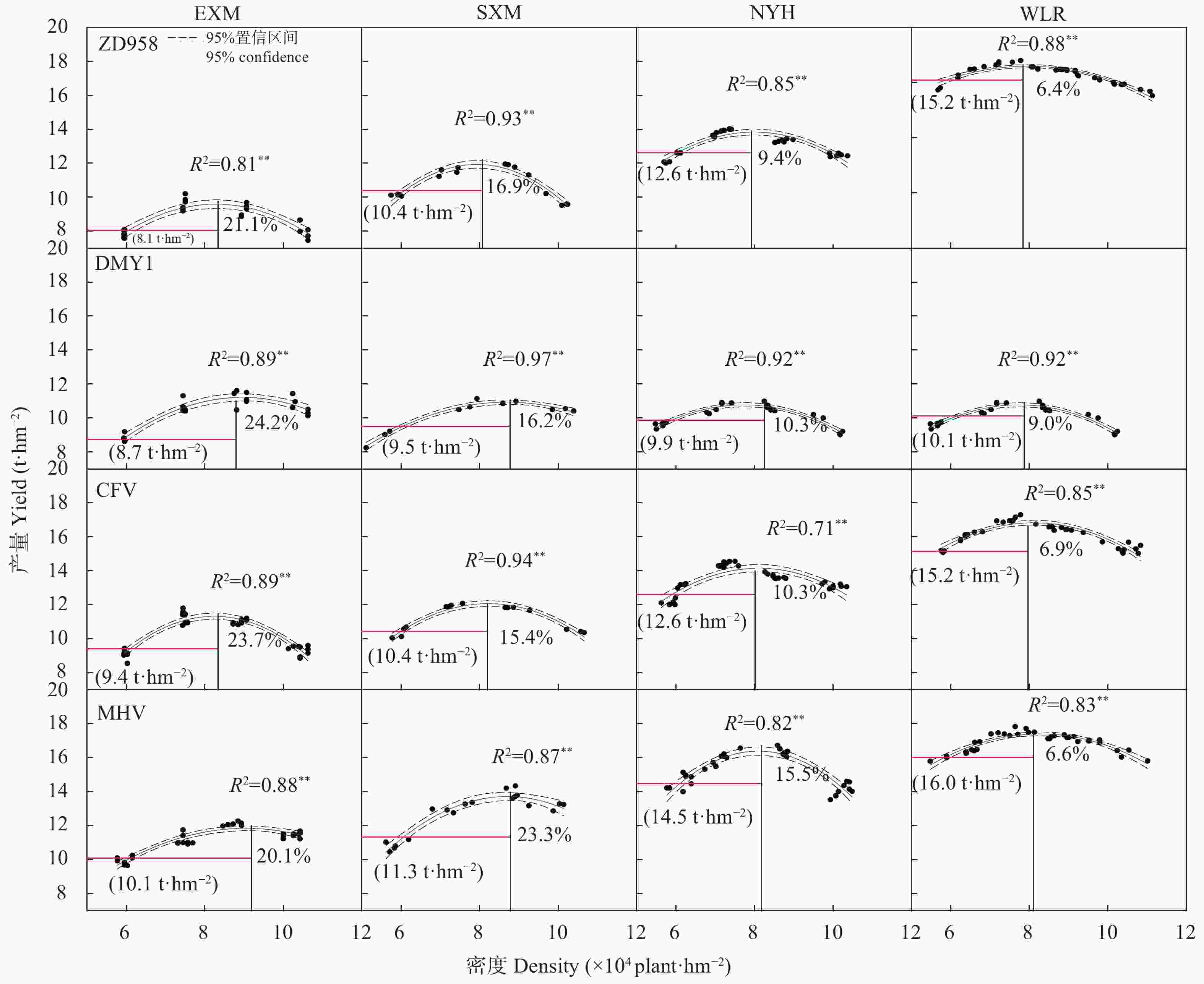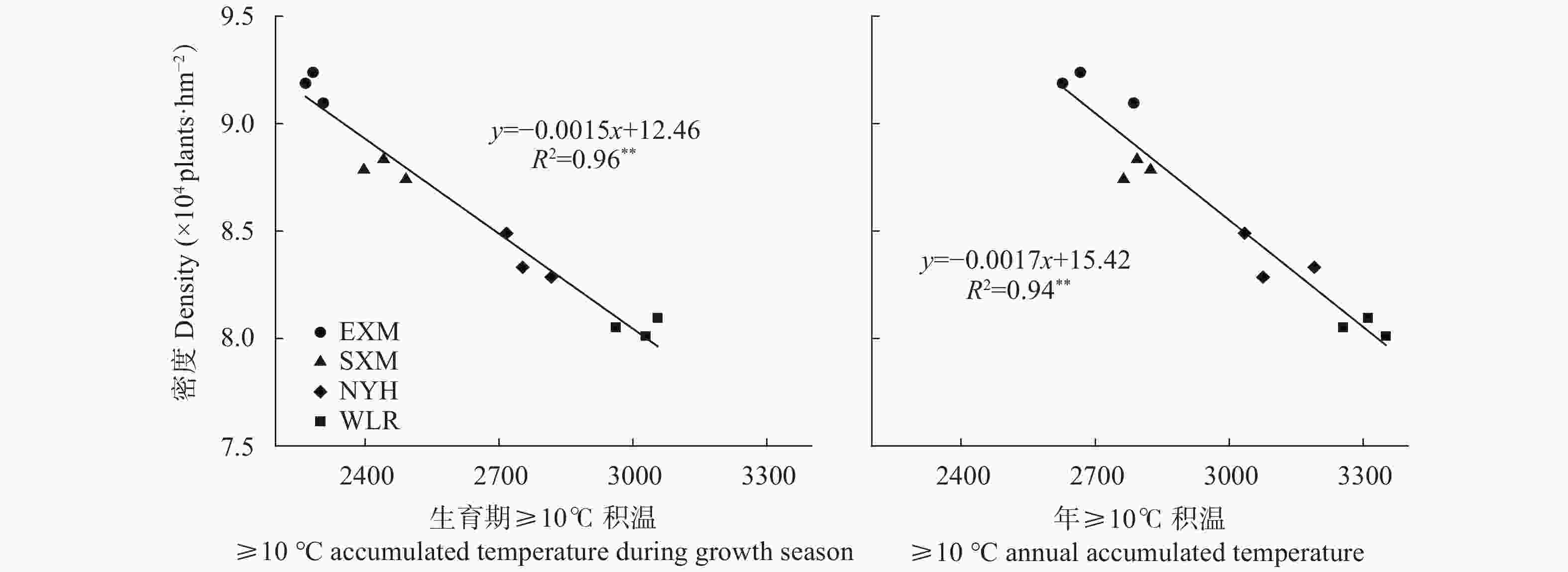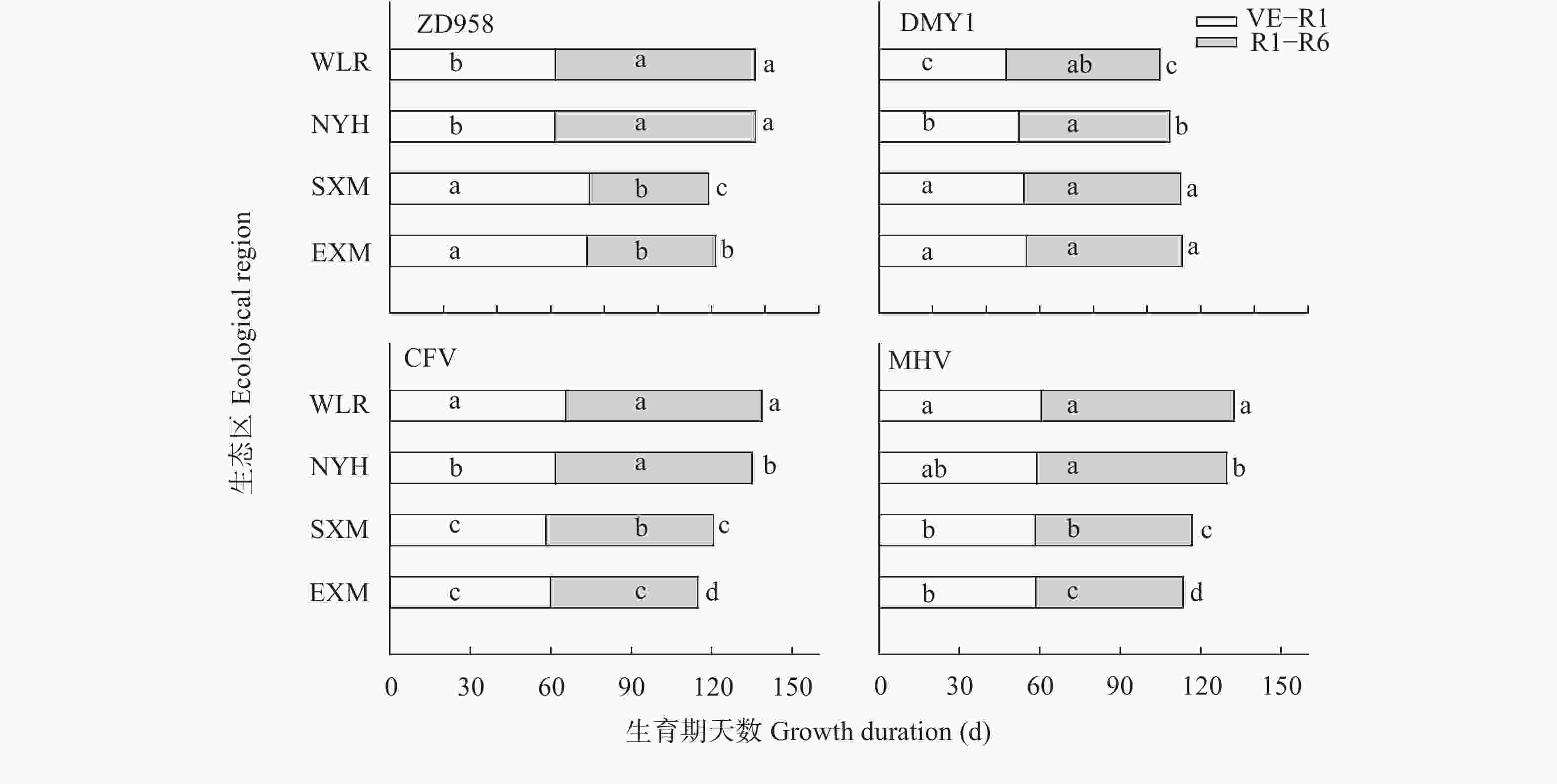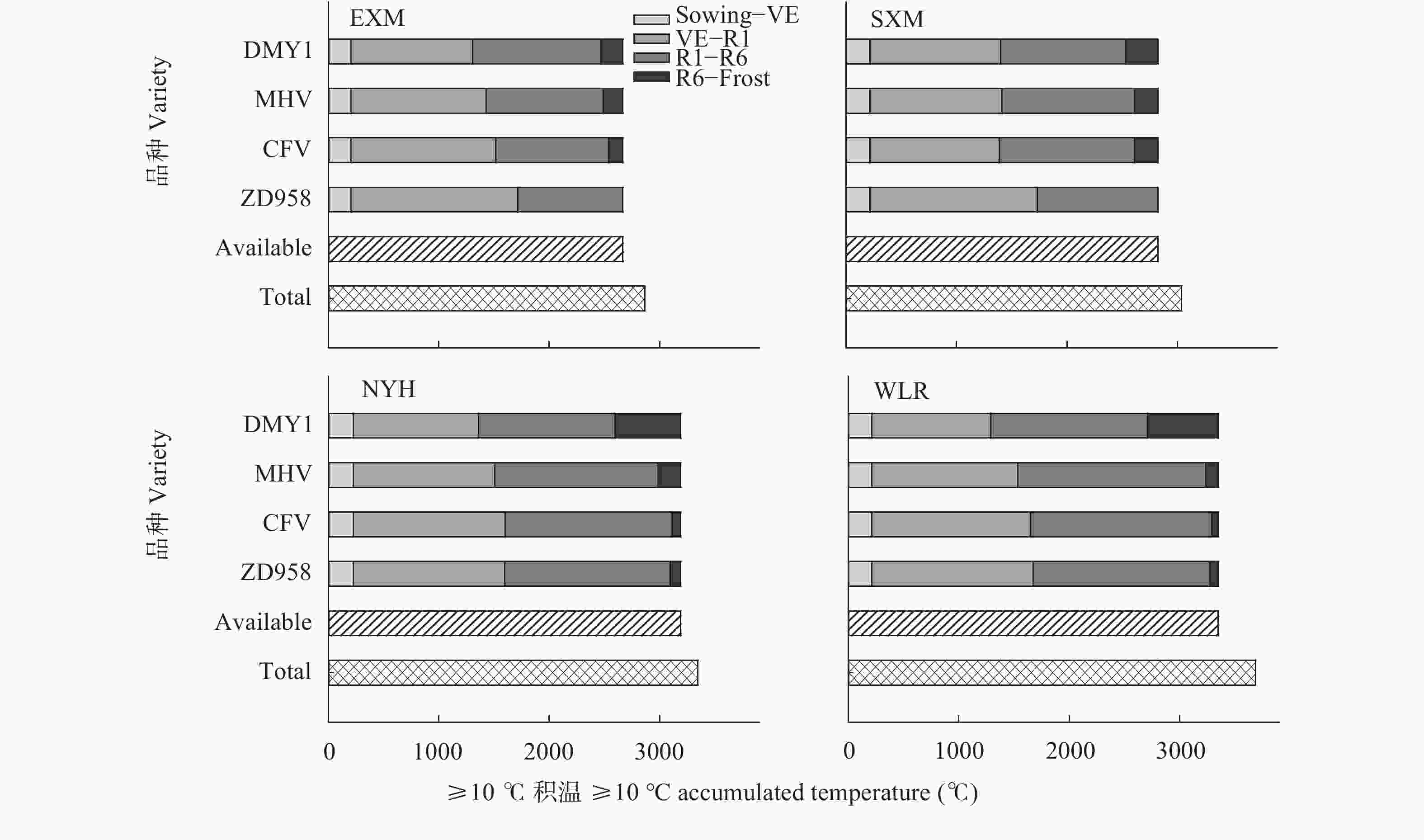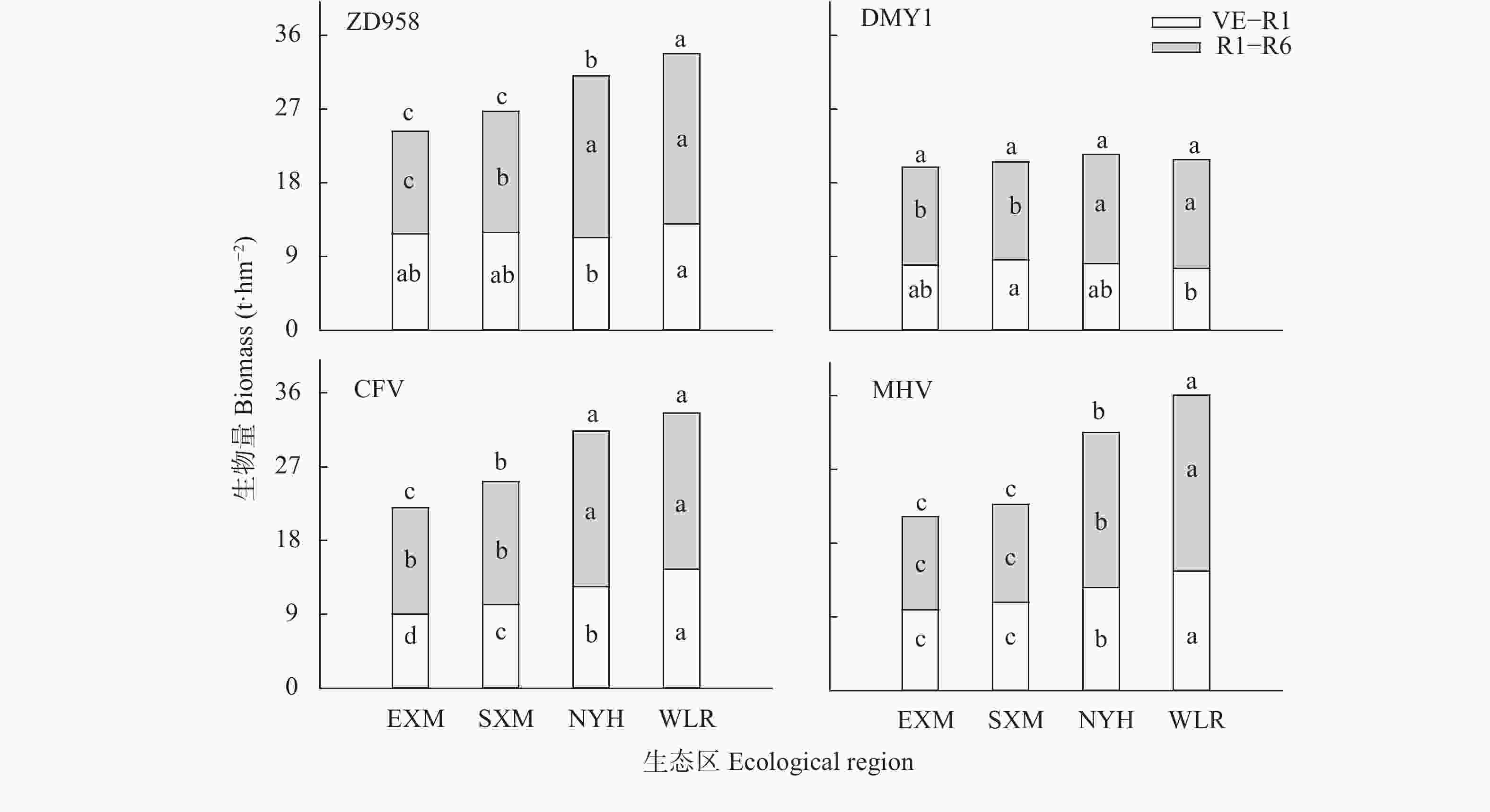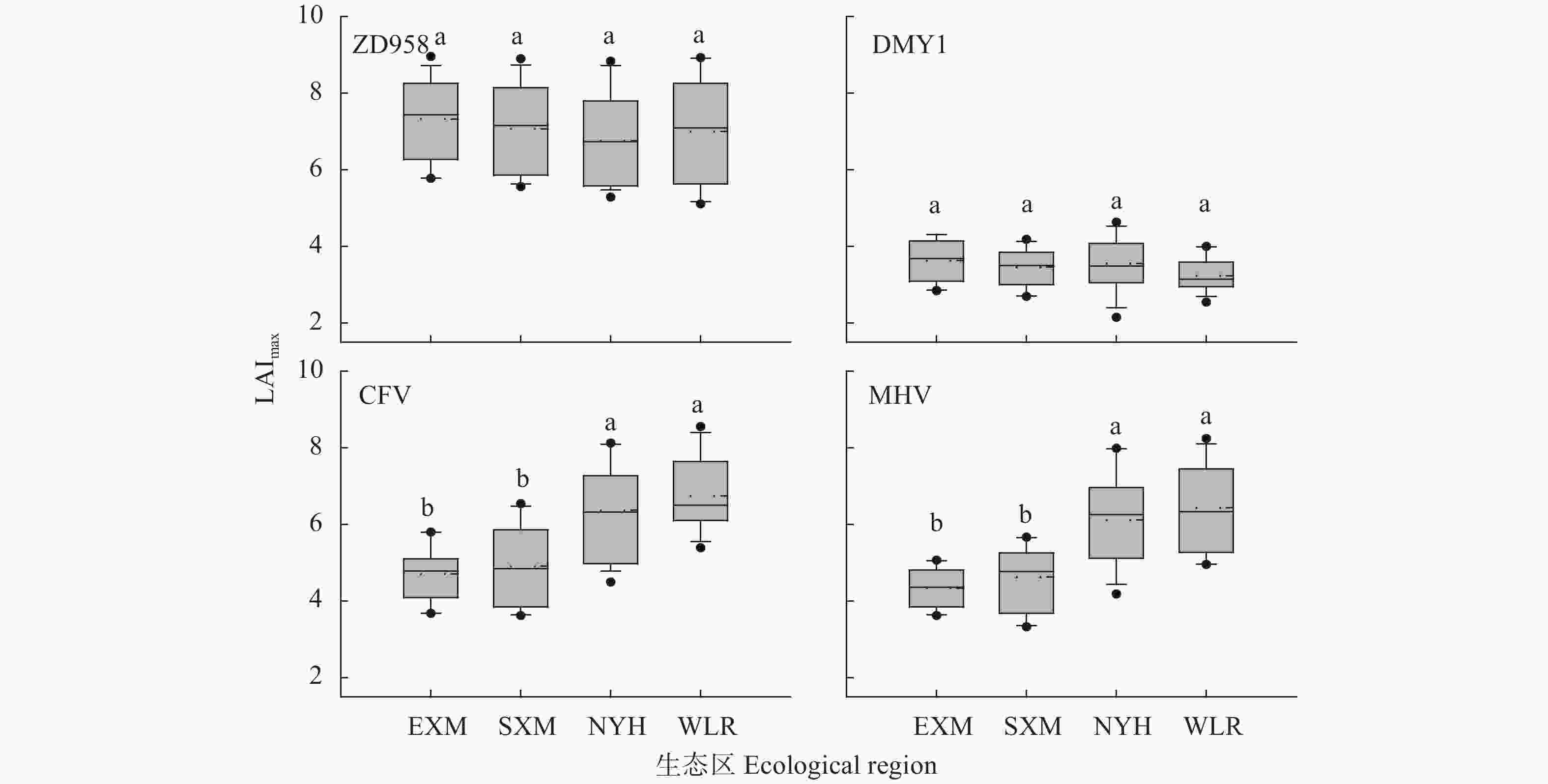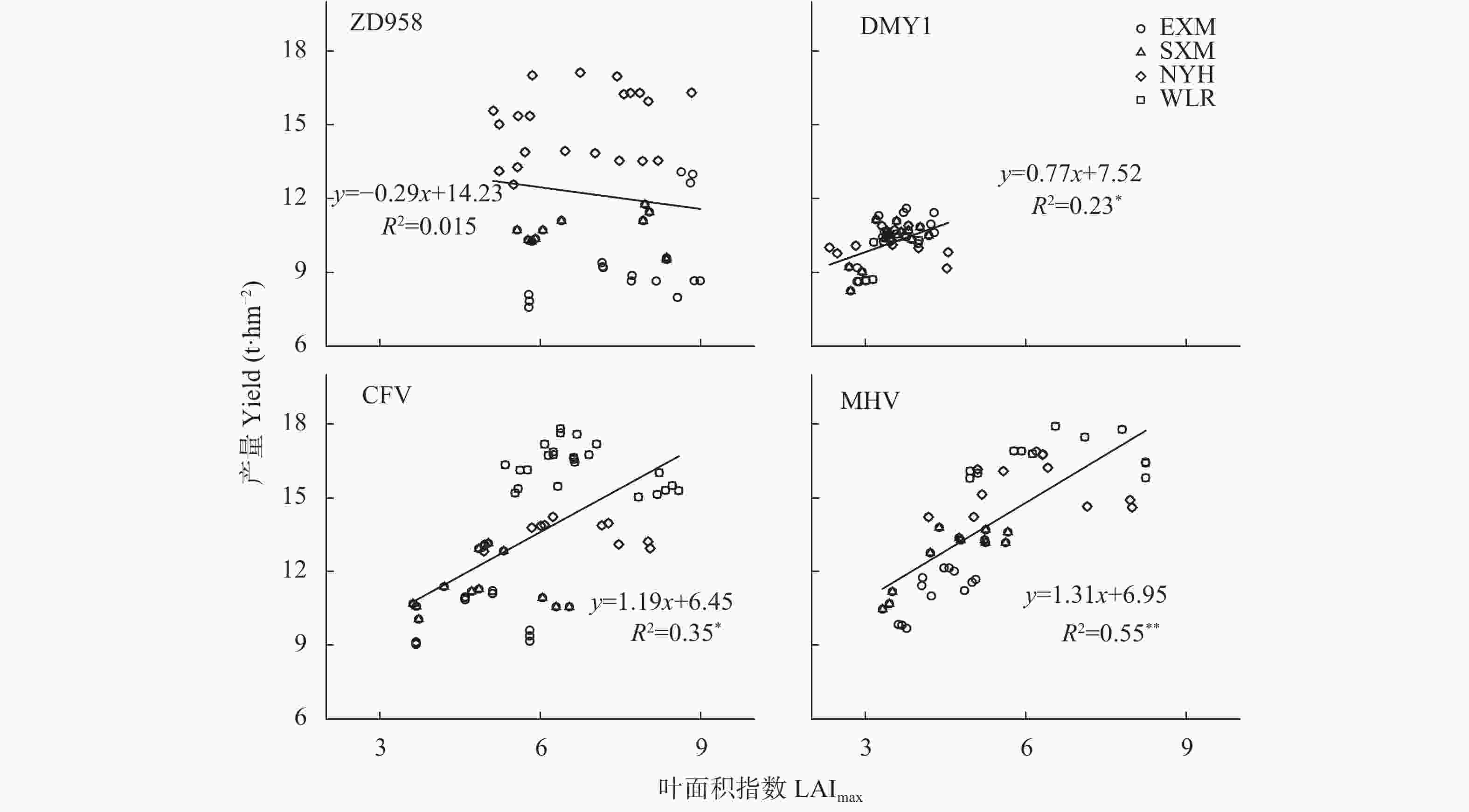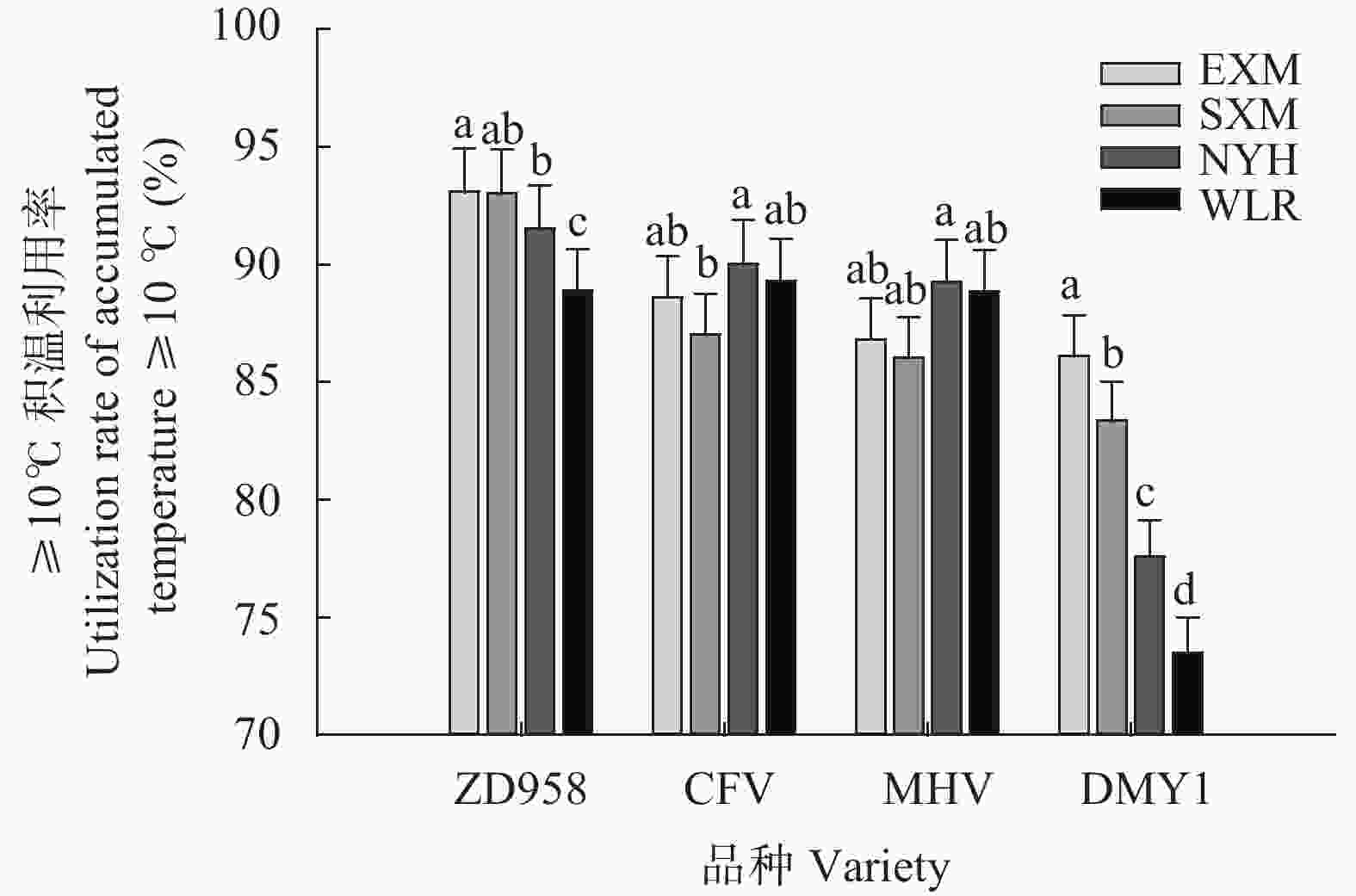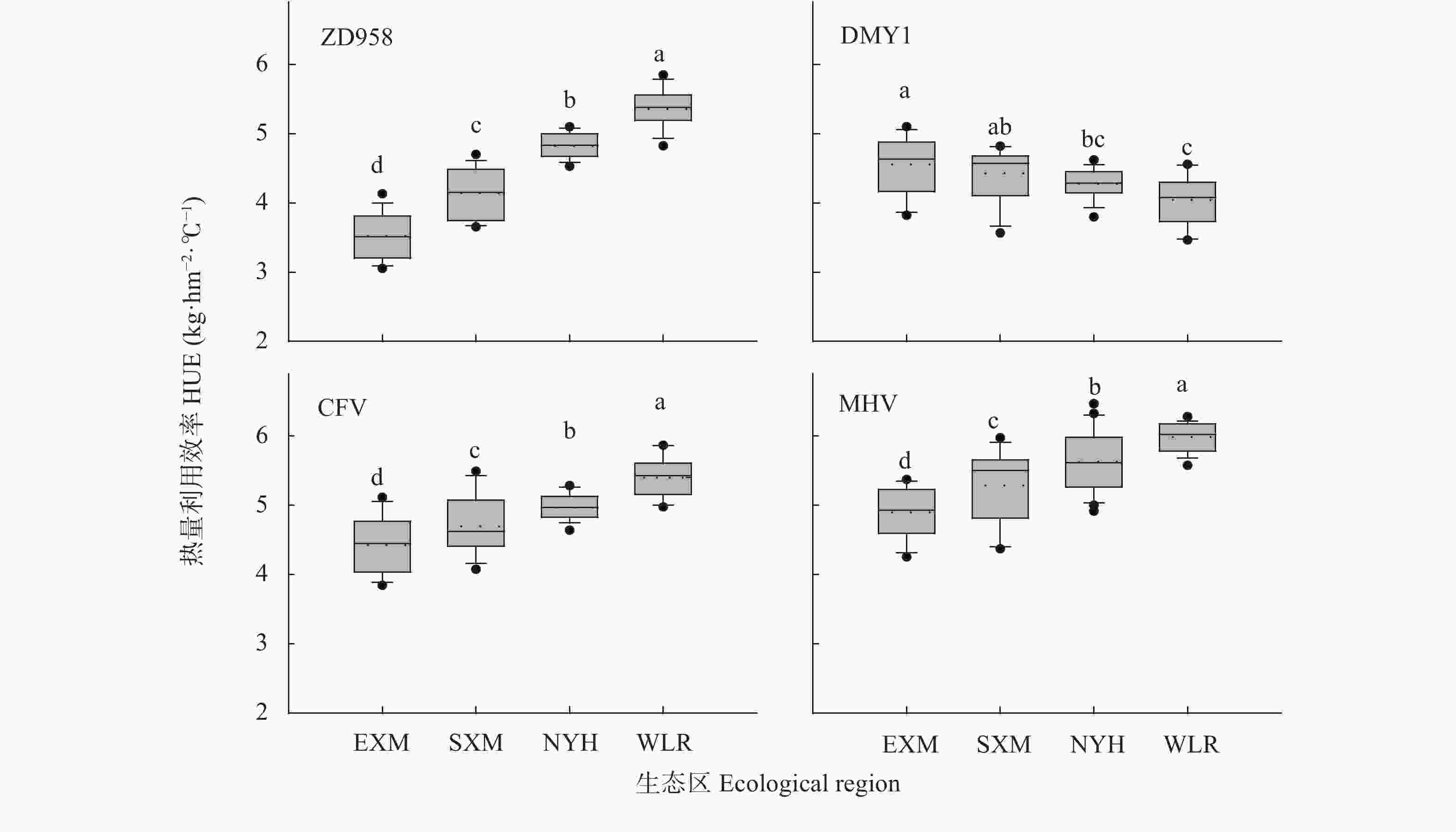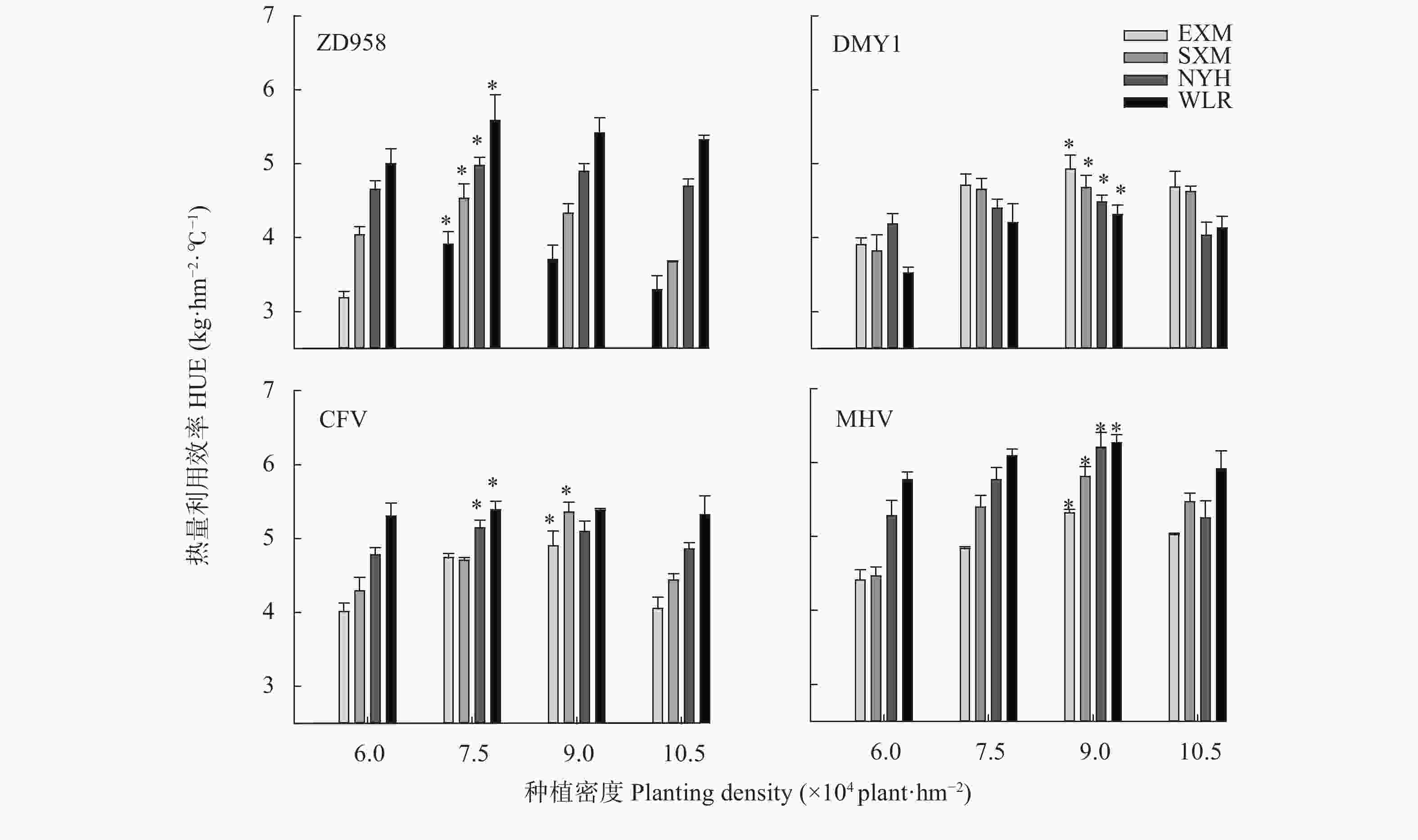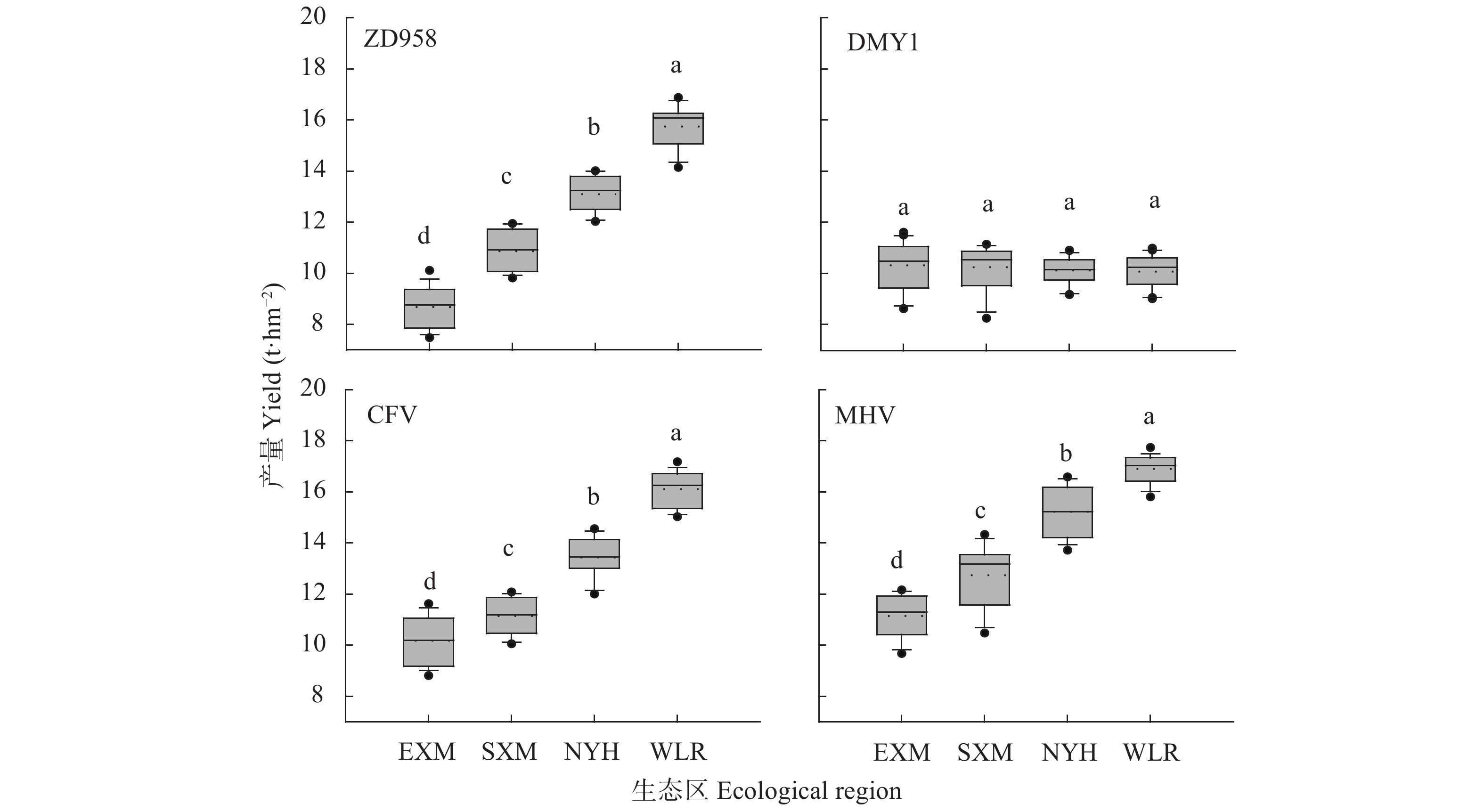Quantification planting density based on heat resource for enhancing grain yield and heat utilization efficiency of grain mechanical harvesting maize
-
摘要: 以缩短熟期换取充分脱水时间的机械粒收品种选择和推广给北方春玉米增产和热量充分利用提出了新的挑战, 揭示不同热量条件下玉米机械粒收品种如何通过合理密植实现产量和热量资源高效利用协同的机制, 可为机械粒收品种高产高效栽培和大面积推广提供理论依据。本研究以不同类型玉米品种为材料, 在内蒙古4个不同热量条件区域[分属于热量充沛地区(以种植中晚熟或晚熟品种为主的生态区)和热量有限地区(以种植中早熟、早熟品种为主的生态区)]进行密度联网试验, 分析密度对不同类型品种阶段发育、产量形成和热量利用效率(HUE)的影响, 并解析其对热量资源的响应规律。结果表明, 机械粒收品种均在区域≥10 ℃积温利用率达86.0%~89.3%的前提下获得最高产量, 各区域机械粒收品种最高产量及其对应密度均高于主推品种, 特别是在热量有限区域差异明显。机械粒收品种最高产量对应密度随热量资源总量增加呈线性降低, 区域≥10 ℃积温每减少100 ℃, 密度需增加0.17万株·hm−2。热量有限地区机械粒收品种的花前∶花后的生育天数比例、≥10 ℃积温比例、生物量比例均趋近5∶5, 实现最高产量需在常规种植密度6.0万株·hm−2的基础上增密2.8万~3.1万株·hm−2, 增密后产量为11.1~12.7 t·hm−2, 可增产20.1%~23.3%, HUE可提高20.6%~30.1%; 热量充沛地区机械粒收品种花前∶花后的生育天数比例及积温比例趋近4.5∶5.5, 花前∶花后的生物量比例为4∶6, 产量为15.4~16.9 t·hm−2, 实现最高产量需在6.0万株·hm−2 基础上增密2.1万~2.3万株·hm−2, 增密后可增产6.1%~11.5%, HUE可提高8.6%~17.5%。可见, 品种热量需求与区域热量资源有效匹配是获得高产并充分挖掘区域产量潜力的前提, 基于热量资源定量密植是春玉米机械粒收品种实现增产和热量资源高效利用协同的有效途径, 热量有限区域花前花后热量资源均衡利用, 实现花前群体生物量充分积累是关键, 适宜密度为8.8万~9.2万株·hm−2; 热量充沛区域挖掘花后物质生产, 构建适宜密度群体, 延缓花后叶片衰老是核心, 适宜密度为8.1万~8.3万株·hm−2。Abstract: The selection and promotion of mechanical grain harvesting maize varieties that shorten the maturity period in exchange for sufficient dehydration time pose new challenges for increase in the yield of spring maize in the north and the full utilization of heat. The use of a synergistic mechanism can provide a theoretical basis for the high-yield and high-efficiency cultivation and large-scale promotion of mechanically grain-harvested varieties of maize. In this study, different types of maize varieties were used as the tested materials, and the density network tests were conducted in four ecological regions of Inner Mongolia with different thermal conditions in eastern Inner Mongolia, which belonged to heat limit area (where medium-early- and early-maturing maize varieties are planted) and heat sufficient area (where the medium-later- or late-maturing varieties are planted), respectively. The effects of planting density on stage development, yield formation, and heat use efficiency (HUE) of different types of maize varieties were analyzed, and their responses to heat resources were analyzed. The results showed that the maximum yield of mechanical grain-harvesting varieties was obtained under the condition that the accumulated temperature utilization rate of ≥10 ℃ reached 86.0%−89.3%. The maximum yield and corresponding density of mechanical grain-harvesting varieties in different regions were higher than those of the current farmers’ variety, especially the differences were obvious in the regions with limited heat. The density of the maximum yield of mechanical grain-harvesting varieties decreased linearly with the increase of the total amount of heat resources. The density increased by 1700 plants·hm−2 for every 100 ℃ decrease of accumulated temperature in the region ≥10 ℃. The areas with limited heat (ecological areas dominated by early-maturing and medium-early-maturing varieties, in this paper, it is east region of Xing’an Mountain and south region of Xing’an Mountain), the proportion of growing days per-silking and post-silking, the proportion of accumulated temperature ≥10 ℃, and the proportion of biomass of mechanical grain-harvesting varieties all approached 5∶5. To achieve the maximum yield, it was necessary to increase the densification from 60 000 plants·hm−2 to 88 000−91 000 plants·hm−2. Increases the density after increasing yield of 11.1−12.7 t·hm−2, yield increase 20.1%−23.3%, and HUE can be increased by 20.6%−30.1%; In areas with abundant heat (ecological areas mainly planted with mid-late maturity or late maturity varieties, this paper refers is the north region of Yanshan Mountain and west Liao River Plain), the ratio of growing days and accumulated temperature per-silking and post silking tended to be 4.5∶5.5, the ratio of biomass at per-silking and post silking was 4∶6, and the yield ranged from 15.4 to 16.9 t·hm−2. The maximum yield needed to be densified from 60000 plant ·hm−2 to 81 000-83 000 plant ·hm−2. After densification, the yield can be increased by 6.1%−11.5%, and the HUE can be increased by 8.6%−17.5%. The effective matching of heat demand of varieties and regional heat resources is the premise to obtain high yield and fully tap the potential of regional yield. Quantitative dense planting based on the matching of heat resources is an effective way to achieve increased yield and efficient utilization of heat resources for mechanical grain-harvesting varieties of spring maize. In the area with limited heat resources, the balance of pre-silking and post-silking at resources and the full accumulation of pre-silking biomass were the key factors, and the suitable density was 88 000 to 92 000 plants·hm−2. In the area with abundant heat, the production of post-silking matter was explored, and the suitable density population was constructed. The maize was to delay post-silking leaf senescence, and the suitable density was 81 000−83 000 plants·hm−2.
-
图 1 不同类型玉米品种在不同生态区产量比较
箱线图中实线代表中位数, 虚线代表平均值, 箱上下边代表上下四分位; EXM、SXM、NYH和WLR分别代表岭东温凉区、岭南温暖区、燕山丘陵区和西辽河平原区。ZD958、DMY1、CFV、MHV分别代表玉米晚熟对照品种‘郑单958’、早熟对照品种‘德美亚1号’、各地主推品种和机械粒收品种。不同小写字母表示不同生态区在P<0.05水平差异显著。The solid line in the boxplot represents the median, the dotted line represents the average, the top and bottom of the box represent the top and bottom quartiles. EXM, SXM, NYH and WLR represent the east region of Xing’an Mountain, the south region of Xing’an Mountain, the north region of Yanshan Mountain, and the west Liao River Plain. ZD958, DMY1, CFV and MHV represent the control late variety ‘Zhengdan 958’, the control early variety ‘Demeiya 1’, the current famers’ variety and the mechanical grain-harvesting variety of maize. Different lowercase letters mean significant differences at P<0.05 level among different ecological regions.
Figure 1. Yield comparison of different maize varieties in different ecological zones
图 2 不同生态区不同类型玉米品种玉米产量随密度变化趋势
上下虚线部分为95%置信区间; 水平直线为6.0万株∙hm−2时玉米产量水平, 括号中数字表示6.0万株·hm−2时玉米产量; 垂直直线为增加密度后可达到的最大产量, 百分数为由6.0万株∙hm−2增密后增产幅度。EXM、SXM、NYH和WLR分别代表岭东温凉区、岭南温暖区、燕山丘陵区和西辽河平原区。ZD958、DMY1、CFV、MHV分别代表玉米晚熟对照品种‘郑单958’、早熟对照品种‘德美亚1号’、各地主推品种和机械粒收品种。
Figure 2. Yield changes of different maize varieties with density in different ecological regions
The upper and lower dotted lines are 95% confidence intervals. The horizontal line is the yield level of maize at 60 000 plant·hm−2, the numbers in brackets indicate the yield at 60 000 plant·hm−2, the vertical line is the maximum yield that can be achieved after increasing density, and the percentage was the increase rate after densification of 60 000 plants·hm−2. EXM, SXM, NYH and WLR represent the east region of Xing’an Mountain, the south region of Xing’an Mountain, the north region of Yanshan Mountain, and the west Liao River Plain. ZD958, DMY1, CFV and MHV represent the control late variety ‘Zhengdan 958’, the control early variety ‘Demeiya 1’, the current famers’ variety and the mechanical grain-harvesting variety of maize.
图 3 不同生态区机械粒收品种获最高产量时种植密度与积温的关系
EXM、SXM、NYH、WLR分别代表岭东温凉区、岭南温暖区、燕山丘陵区和西辽河平原区。EXM, SXM, NYH and WLR represent the east region of Xing’an Mountain, the south region of Xing’an Mountain, the north region of Yanshan Mountain, and the west Liao River Plain.
Figure 3. Relationship between planting density and accumulated temperature during maize growth season and annual accumulated temperature when mechanical grain-harvesting maize varieties achieve maximum yield in different ecological region
图 4 不同生态区不同类型玉米品种花前花后生育天数比较
VE−R1和R1−R6分别表示玉米花前、花后阶段。EXM、SXM、NYH和WLR分别代表岭东温凉区、岭南温暖区、燕山丘陵区和西辽河平原区。ZD958、DMY1、CFV和MHV分别代表玉米晚熟对照品种‘郑单958’、早熟对照品种‘德美亚1号’、各地主推品种和机械粒收品种。不同小写字母表示不同生态区在P<0.05水平差异显著。VE−R1 and R1−R6 represent the pre-silking and post-silking stages of maize. EXM, SXM, NYH and WLR represent the east region of Xing’an Mountain, the south region of Xing’an Mountain, the north region of Yanshan Mountain, and the west Liao River Plain. ZD958, DMY1, CFV and MHV represent the control late variety ‘Zhengdan 958’, the control early variety ‘Demeiya 1’, the current famers’ variety and the mechanical grain-harvesting variety of maize. Different lowercase letters mean significant differences at P<0.05 level among different ecological regions.
Figure 4. Comparison of growing days per-silking and post-silking of different maize varieties in different ecological regions
图 5 不同热量条件下不同生态区不同类型玉米品种生育阶段积温分配比较
Available表示玉米生长季可用≥10 ℃积温, Total表示生态区内全年≥10 ℃积温。Sowing−VE、VE−R1、R1−R6、R6−Frost分别表示玉米播种—出苗、花前、花后、生理成熟—初霜期。EXM、SXM、NYH、WLR分别代表岭东温凉区、岭南温暖区、燕山丘陵区和西辽河平原区。ZD958、DMY1、CFV和MHV分别代表玉米晚熟对照品种‘郑单958’、早熟对照品种‘德美亚1号’、各地主推品种和机械粒收品种。“Available” indicates the ≥10 ℃ accumulated temperature in the growing season of maize, and “Total” indicates the annual ≥10 ℃ accumulated temperature in the ecological region. Sowing−VE, VE−R1, R1−R6 and R6−Frost represent maize stages of sowing−emergence, pre-silking, post-silking, physiological maturity−first frost period. EXM, SXM, NYH and WLR represent the east region of Xing’an Mountain, the south region of Xing’an Mountain, the north region of Yanshan Mountain, and the west Liao River Plain. ZD958, DMY1, CFV and MHV represent the control late variety ‘Zhengdan 958’, the control early variety ‘Demeiya 1’, the current famers’ variety and the mechanical grain-harvesting variety of maize.
Figure 5. Comparison of accumulated temperature distribution in different growth stages of different maize varieties under different heat conditions
图 6 不同生态区不同类型玉米品种生物量比较
VE−R1、R1−R6分别表示玉米花前、花后阶段。EXM、SXM、NYH、WLR分别代表岭东温凉区、岭南温暖区、燕山丘陵区和西辽河平原区。ZD958、DMY1、CFV和MHV分别代表玉米晚熟对照品种‘郑单958’、早熟对照品种‘德美亚1号’、各地主推品种和机械粒收品种。不同小写字母表示不同生态区在P<0.05水平差异显著。VE−R1 and R1−R6 represent maize stage of pre-silking and post-silking. EXM, SXM, NYH and WLR represent the east region of Xing’an Mountain, the south region of Xing’an Mountain, the north region of Yanshan Mountain, and the west Liao River Plain. ZD958, DMY1, CFV and MHV represent the control late variety ‘Zhengdan 958’, the control early variety ‘Demeiya 1’, the current famers’ variety and the mechanical grain-harvesting variety of maize. Different lowercase letters mean significant differences at P<0.05 level among different ecological regions.
Figure 6. Biomass comparison of different maize varieties in different ecological regions
图 7 不同生态区不同类型玉米的最大叶面积指数(LAImax)
EXM、SXM、NYH、WLR分别代表岭东温凉区、岭南温暖区、燕山丘陵区和西辽河平原区。ZD958、DMY1、CFV和MHV分别代表玉米晚熟对照品种‘郑单958’、早熟对照品种‘德美亚1号’、各地主推品种和机械粒收品种。不同小写字母表示不同生态区在P<0.05水平差异显著。EXM, SXM, NYH and WLR represent the east region of Xing’an Mountain, the south region of Xing’an Mountain, the north region of Yanshan Mountain, and the west Liao River Plain. ZD958, DMY1, CFV and MHV represent the control late variety ‘Zhengdan 958’, the control early variety ‘Demeiya 1’, the current famers’ variety and the mechanical grain-harvesting variety of maize. Different lowercase letters mean significant differences at P<0.05 level among different ecologicals.
Figure 7. Maximum leaf area indexes (LAImax) fo difference maize varieties in different ecological regions
图 8 不同生态区不同类型玉米品种最大叶面积指数(LAImax)对产量的影响
EXM、SXM、NYH、WLR分别代表岭东温凉区、岭南温暖区、燕山丘陵区和西辽河平原区。ZD958、DMY1、CFV、MHV分别代表玉米晚熟对照品种‘郑单958’、早熟对照品种‘德美亚1号’、各地主推品种和机械粒收品种。EXM, SXM, NYH and WLR represent the east region of Xing’an Mountain, the south region of Xing’an Mountain, the north region of Yanshan Mountain, and the west Liao River Plain. ZD958, DMY1, CFV and MHV represent the control late variety ‘Zhengdan 958’, the control early variety ‘Demeiya 1’, the current famers’ variety and the mechanical grain-harvesting variety of maize.
Figure 8. Effects of maximum leaf area index (LAImax) on yielddifferent maize varieties in different ecological regions
图 9 不同生态区不同类型玉米品种≥10 ℃积温利用率
EXM、SXM、NYH、WLR分别代表岭东温凉区、岭南温暖区、燕山丘陵区和西辽河平原区。ZD958、DMY1、CFV和MHV分别代表玉米晚熟对照品种‘郑单958’、早熟对照品种‘德美亚1号’、各地主推品种和机械粒收品种。不同小写字母表示不同生态区在P<0.05水平差异显著。EXM, SXM, NYH and WLR represent the east region of Xing’an Mountain, the south region of Xing’an Mountain, the north region of Yanshan Mountain, and the west Liao River Plain. ZD958, DMY1, CFV and MHV represent the control late variety ‘Zhengdan 958’, the control early variety ‘Demeiya 1’, the current famers’ variety and the mechanical grain-harvesting variety of maize. Different lowercase letters mean significant differences at P<0.05 level among different ecological regions.
Figure 9. Utilization rate of accumulated temperature ≥10 ℃ for different maize varieties in different ecological regions
图 10 不同生态区不同类型玉米品种的热量利用效率
EXM、SXM、NYH、WLR分别代表岭东温凉区、岭南温暖区、燕山丘陵区和西辽河平原区。ZD958、DMY1、CFV和MHV分别代表玉米晚熟对照品种‘郑单958’、早熟对照品种‘德美亚1号’、各地主推品种和机械粒收品种。不同小写字母表示不同生态区在P<0.05水平差异显著。EXM, SXM, NYH and WLR represent the east region of Xing’an Mountain, the south region of Xing’an Mountain, the north region of Yanshan Mountain, and the west Liao River Plain. ZD958, DMY1, CFV and MHV represent the control late variety ‘Zhengdan 958’, the control early variety ‘Demeiya 1’, the current famers’ variety and the mechanical grain-harvesting variety of maize. Different lowercase letters mean significant differences at P<0.05 level among different ecological regions.
Figure 10. Heat resource utilization efficiency (HUE) of different maize varieties in different ecological regions
图 11 不同生态区不同类型玉米品种种植密度对玉米热量利用效率的影响
图中“*”表示该品种最大HUE。EXM、SXM、NYH、WLR分别代表岭东温凉区、岭南温暖区、燕山丘陵区和西辽河平原区, ZD958、DMY1、CFV、MHV分别代表玉米晚熟对照品种‘郑单958’、早熟对照品种‘德美亚1号’、各地主推品种和机械粒收品种。“*” in the figure indicates the maximum value of HUE. EXM, SXM, NYH and WLR represent the east region of Xing’an Mountain, the south region of Xing’an Mountain, the north region of Yanshan Mountain, and the west Liao River Plain. ZD958, DMY1, CFV and MHV represent the control late variety ‘Zhengdan 958’, the control early variety ‘Demeiya 1’, the current famers’ variety and the mechanical grain-harvesting variety of maize.
Figure 11. Effect of planting density on heat resource utilization efficiency (HUE) of different maize varieties in different ecological regions
表 1 各生态区试验点地理位置和玉米生育期平均热量条件
Table 1. Location and thermal conditions during spring maize season of the experiment sites in each ecological region
生态区
Ecological region纬度
Latitude经度
Longitude≥10 ℃积温
≥10 ℃ accumulated
temperature (℃)日最高温
Daily maximum
temperature (℃)日最低温
Daily minimum
temperature (℃)日均温
Daily mean
temperature (℃)昼夜温差
Diurnal range (℃)热量有限地区
Heat limit area岭东温凉区 EXM 47°20′N 122°22′E 2865.1 23.3 9.9 16.3 13.4 岭南温暖区 SXM 46°45′N 122°47′E 3035.8 24.4 11.4 17.3 12.6 热量充足地区
Heat sufficient area燕山丘陵区 NYH 42°18′N 118°10′E 3344.5 24.9 12.3 17.9 12.3 西辽河平原 WLR 43°44′N 122°32′E 3686.5 25.8 14.3 19.7 11.5 热量有限地区是以种植中早熟、早熟品种为主的生态区; 热量充足地区是以种植中晚熟或晚熟品种为主的生态区。The heat limit area is the rgeions where medium-early- and early-maturing maize varieties are planted; the heat sufficient area is the regions where the medium-later- or late-maturing varieties are planted. EXM: east region of Xing’an Mountain; SXM: south region of Xing’an Mountain; NYH: north region of Yanshan Mountain; WLR: west Liao River Plain. 表 2 各生态区试验点的供试品种及其积温要求
Table 2. Tested varieties and their accumulated temperature requirement in the experiment sites of each ecological region
生态区
Ecological region共性品种
Common variety主推品种
Current famers’ variety机械粒收品种
Mechanical grain-harvesting variety岭东温凉区 EXM 郑单958 (3100 ℃)
Zhengdan958
德美亚1号 (2200 ℃)
Demeiya138P05 (2300 ℃) J6518 (2050 ℃) 岭南温暖区 SXM 丰垦139 (2450 ℃) Fengken139 C1563 (2400 ℃) 燕山丘陵区 NYH 京科968 (3000 ℃) Jingke968 迪卡159 (2600 ℃) Dika159 西辽河平原 WLR 京科968 (3000 ℃) Jingke968 迪卡159 (2600 ℃) Dika159 品种后对应的温度数字为玉米全生育期所需积温。The number of temperature corresponding to the variety is the accumulated temperature required in the whole growth period of maize. EXM: east region of Xing’an Mountain; SXM: south region of Xing’an Mountain; NYH: north region of Yanshan Mountain; WLR: west Liao River Plain. -
[1] 李少昆, 赵久然, 董树亭, 等. 中国玉米栽培研究进展与展望[J]. 中国农业科学, 2017, 50(11): 1941−1959 doi: 10.3864/j.issn.0578-1752.2017.11.001LI S K, ZHAO J R, DONG S T, et al. Advances and prospects of maize cultivation in China[J]. Scientia Agricultura Sinica, 2017, 50(11): 1941−1959 doi: 10.3864/j.issn.0578-1752.2017.11.001 [2] 李少昆, 王克如, 谢瑞芝, 等. 机械粒收推动玉米生产方式转型[J]. 中国农业科学, 2018, 51(10): 1842−1844 doi: 10.3864/j.issn.0578-1752.2018.10.003LI S K, WANG K R, XIE R Z, et al. Grain mechanical harvesting technology promotes the transformation of maize production mode[J]. Scientia Agricultura Sinica, 2018, 51(10): 1842−1844 doi: 10.3864/j.issn.0578-1752.2018.10.003 [3] 李少昆. 我国玉米机械粒收质量影响因素及粒收技术的发展方向[J]. 石河子大学学报: 自然科学版, 2017, 35(3): 265−272LI S K. Factors affecting the quality of maize grain mechanical harvest and the development trend of grain harvest technology[J]. Journal of Shihezi University: Natural Science, 2017, 35(3): 265−272 [4] WANG X Y, WANG X L, XU C C, et al. Decreased kernel moisture in medium-maturing maize hybrids with high yield for mechanized grain harvest[J]. Crop Science, 2019, 59(6): 2794−2805 doi: 10.2135/cropsci2019.04.0218 [5] 黄兆福, 明博, 王克如, 等. 辽河流域玉米籽粒脱水特点及适宜收获期分析[J]. 作物学报, 2019, 45(6): 922−931HUANG Z F, MING B, WANG K R, et al. Characteristics of maize grain dehydration and prediction of suitable harvest period in Liao River Basin[J]. Acta Agronomica Sinica, 2019, 45(6): 922−931 [6] 王美云. 热量限制两熟区双季青贮玉米模式及其技术体系研究[D]. 北京: 中国农业科学院, 2006WANG M Y. Study on mode and technique of two harvests silage maize in the temperature limited region of double cropping system[D]. Beijing: Chinese Academy of Agricultural Sciences, 2006 [7] 张宝林, 高聚林, 王志刚, 等. 内蒙古玉米主产区农业热量资源变化及其对策探讨[J]. 农业资源与环境学报, 2019, 36(6): 757−765ZHANG B L, GAO J L, WANG Z G, et al. Agricultural thermal resource changes and corresponding agricultural strategies in major maize production regions of Inner Mongolia[J]. Journal of Agricultural Resources and Environment, 2019, 36(6): 757−765 [8] 郭佳, 张宝林, 高聚林, 等. 内蒙古东部农业热量资源的空间分异及玉米资源利用率[J]. 西北农业学报, 2020, 29(3): 476−486 doi: 10.7606/j.issn.1004-1389.2020.03.019GUO J, ZHANG B L, GAO J L, et al. Spatial heterogeneity of agricultural thermal resources and use efficiency of maize in eastern Inner Mongolia[J]. Acta Agriculturae Boreali-Occidentalis Sinica, 2020, 29(3): 476−486 doi: 10.7606/j.issn.1004-1389.2020.03.019 [9] MA D L, XIE R Z, NIU X K, et al. Changes in the morphological traits of maize genotypes in China between the 1950s and 2000s[J]. European Journal of Agronomy, 2014, 58: 1−10 doi: 10.1016/j.eja.2014.04.001 [10] 赵放, 王锐, 赵慧颖, 等. 寒地玉米生产热量利用效率潜力演变特征[J]. 玉米科学, 2019, 27(3): 73−81ZHAO F, WANG R, ZHAO H Y, et al. Evolution characteristics of potential heat utilization efficiency in maize production in cold region[J]. Journal of Maize Sciences, 2019, 27(3): 73−81 [11] XU W J, LIU C W, WANG K R, et al. Adjusting maize plant density to different climatic conditions across a large longitudinal distance in China[J]. Field Crops Research, 2017, 212: 126−134 doi: 10.1016/j.fcr.2017.05.006 [12] 李作一, 段宏凯, 田森林, 等. 山西省中晚熟玉米种植区不同品种穗部性状差异分析[J]. 中国农学通报, 2018, 34(24): 13−17 doi: 10.11924/j.issn.1000-6850.casb18030019LI Z Y, DUAN H K, TIAN S L, et al. Variation of ear traits of maize varieties in the middle and late maturity areas in Shanxi[J]. Chinese Agricultural Science Bulletin, 2018, 34(24): 13−17 doi: 10.11924/j.issn.1000-6850.casb18030019 [13] YOUSAF M I, HUSSAIN K, HUSSAIN S, et al. Seasonal influence, heat unit accumulation and heat use efficiency in relation to maize grain yield in Pakistan[J]. Maydica, 2020, 64(3): 1−9 [14] 廉军, 姜立雁, 李福林, 等. 德美亚系列玉米杂交种对早熟玉米育种的启示[J]. 热带农业工程, 2019, 43(3): 1−3LIAN J, JIANG L Y, LI F L, et al. Enlightenment of demeiya series maize hybrids on early maturing maize breeding[J]. Tropical Agricultural Engineering, 2019, 43(3): 1−3 [15] 宋保谦. 浅析郑单958的特点及推广应用前景[J]. 农业科技通讯, 2006, (10): 9−10 doi: 10.3969/j.issn.1000-6400.2006.10.005SONG B Q. Characters of Zhengdan 958 and its prospects in extension and application[J]. Bulletin of Agricultural Science and Technology, 2006, (10): 9−10 doi: 10.3969/j.issn.1000-6400.2006.10.005 [16] LIU Y E, HOU P, XIE R Z, et al. Spatial adaptabilities of spring maize to variation of climatic conditions[J]. Crop Science, 2013, 53(4): 1693−1703 doi: 10.2135/cropsci2012.12.0688 [17] 白彩云, 李少昆, 柏军华, 等. 我国东北地区不同生态条件下玉米品种积温需求及利用特征[J]. 应用生态学报, 2011, 22(9): 2337−2342BAI C Y, LI S K, BAI J H, et al. Characteristics of accumulated temperature demand and its utilization of maize under different ecological conditions in Northeast China[J]. Chinese Journal of Applied Ecology, 2011, 22(9): 2337−2342 [18] 钱春荣, 王荣焕, 于洋, 等. 生态区对不同熟期玉米品种生长发育与有效积温生产效率的影响[J]. 黑龙江农业科学, 2020, (9): 1−8QIAN C R, WANG R H, YU Y, et al. Effects of ecological zone on growth and development and effective accumulated temperature production efficiency of maize varieties differing in maturity[J]. Heilongjiang Agricultural Sciences, 2020, (9): 1−8 [19] 杨哲, 于胜男, 高聚林, 等. 主要栽培措施对北方春玉米产量贡献的定量评估[J]. 中国农业科学, 2020, 53(15): 3024−3035 doi: 10.3864/j.issn.0578-1752.2020.15.004YANG Z, YU S N, GAO J L, et al. Quantitative evaluation of the contribution of main management factors to grain yield of spring maize in North China[J]. Scientia Agricultura Sinica, 2020, 53(15): 3024−3035 doi: 10.3864/j.issn.0578-1752.2020.15.004 [20] ANTONIETTA M, FANELLO D D, ACCIARESI H A, et al. Senescence and yield responses to plant density in stay green and earlier-senescing maize hybrids from Argentina[J]. Field Crops Research, 2014, 155: 111−119 doi: 10.1016/j.fcr.2013.09.016 [21] 王楷, 王克如, 王永宏, 等. 密度对玉米产量(>15 000 kg·hm−2)及其产量构成因子的影响[J]. 中国农业科学, 2012, 45(16): 3437−3445 doi: 10.3864/j.issn.0578-1752.2012.16.025WANG K, WANG K R, WANG Y H, et al. Effects of density on maize yield and yield components[J]. Scientia Agricultura Sinica, 2012, 45(16): 3437−3445 doi: 10.3864/j.issn.0578-1752.2012.16.025 [22] ASSEFA Y, CARTER P, HINDS M, et al. Analysis of long term study indicates both agronomic optimal plant density and increase maize yield per plant contributed to yield gain[J]. Scientific Reports, 2018, 8: 4937 doi: 10.1038/s41598-018-23362-x [23] 李宏志, 卓从丽, 廖斌, 等. 种植密度对不同株型春玉米品种源库关系及产量的影响[J]. 湖南农业科学, 2019, (11): 25−27LI H Z, ZHUO C L, LIAO B, et al. Effects of planting density on source sink relationship and yield of different plant types of spring maize[J]. Hunan Agricultural Sciences, 2019, (11): 25−27 [24] 刘春晓, 董瑞, 张秀芝, 等. 不同种植密度对玉米叶面积指数、干物质积累及产量的影响[J]. 山东农业科学, 2017, 49(2): 36−39LIU C X, DONG R, ZHANG X Z, et al. Effects of different planting densities on leaf area index, dry matter accumulation and yield of maize[J]. Shandong Agricultural Sciences, 2017, 49(2): 36−39 [25] 侯玉虹, 陈传永, 郭志强, 等. 春玉米不同产量群体叶面积指数动态特征与生态因子资源量的分配特点[J]. 应用生态学报, 2009, 20(1): 135−142HOU Y H, CHEN C Y, GUO Z Q, et al. Dynamic characteristics of leaf area index and allocation characters of ecological resources for different yielding spring maize populations[J]. Chinese Journal of Applied Ecology, 2009, 20(1): 135−142 [26] 孙继颖, 高聚林, 王志刚, 等. 青贮玉米不同器官产量贡献率对密度调控的响应[J]. 华北农学报, 2020, 35(1): 96−105 doi: 10.7668/hbnxb.20190398SUN J Y, GAO J L, WANG Z G, et al. Response by planting density on yield contribution of different organ to the whole plant in silage maize[J]. Acta Agriculturae Boreali-Sinica, 2020, 35(1): 96−105 doi: 10.7668/hbnxb.20190398 [27] 孙孟梅, 姜丽霞, 于荣环, 等. 玉米生育期热量指标及其不同品种栽培北界的研究[J]. 中国农业气象, 1998, 19(4): 9−13SUN M M, JIANG L X, YU R H, et al. Study on heat index at growing stages of corn and the planting border of different varieties in the north[J]. Agricultural Meteorology, 1998, 19(4): 9−13 [28] 孙锐, 彭畅, 丛艳霞, 等. 不同密度春玉米叶面积系数动态特征及其对产量的影响[J]. 玉米科学, 2008, 16(4): 61−65SUN R, PENG C, CONG Y X, et al. Dynamic characteristics of leaf area index and their effects on yield in different density spring-maize[J]. Journal of Maize Sciences, 2008, 16(4): 61−65 [29] LIU W M, HOU P, LIU G Z, et al. Contribution of total dry matter and harvest index to maize grain yield — A multisource data analysis[J]. Food and Energy Security, 2020. DOI: 10.1002/fes3.256 [30] ASSEFA Y, VARA PRASAD P V, CARTER P, et al. Yield responses to planting density for US modern corn hybrids: a synthesis-analysis[J]. Crop Science, 2016, 56(5): 2802−2817 doi: 10.2135/cropsci2016.04.0215 [31] IQBAL M, ANWAR-UL-HASSAN, IBRAHIM M. Effects of tillage systems and mulch on soil physical quality parameters and maize (Zea mays L.) yield in semi-arid Pakistan[J]. Biological Agriculture & Horticulture, 2008, 25(4): 311−325 [32] LIU Y, PENG H, XIE R Z, et al. Spatial variation and improving measures of the utilization efficiency of accumulated temperature[C]//Proceedings of the 14th National Symposium on Maize Cultivation. Baoding: 2015 -





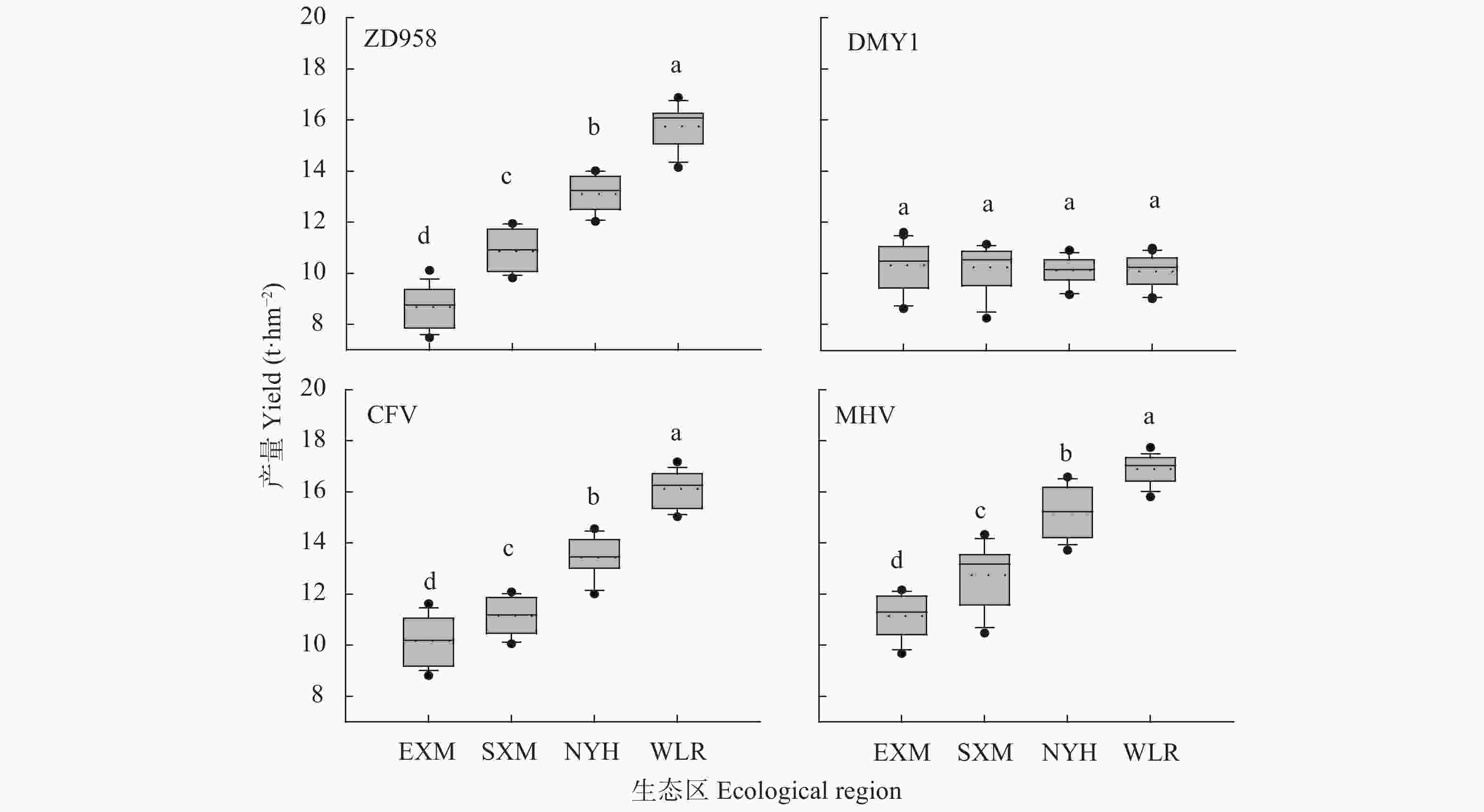
 下载:
下载:
